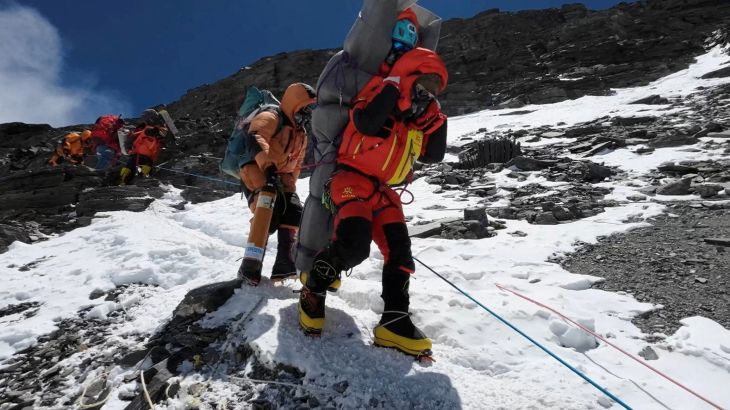Sherpa saves Malaysian climber in Everest ‘death zone’ rescue
Gelje Sherpa found the Malaysian hanging from a rope and shivering in an area where temperatures can dip below minus 30C (86F).

A Malaysian climber narrowly survived Mount Everest after a Nepali Sherpa guide hauled him down from below the summit in a “very rare” high-altitude rescue, according to a government official.
Gelje Sherpa, 30, was guiding a Chinese client to the 8,849-metre (29,032 feet) summit of Everest on May 18, when he saw the Malaysian climber clinging to a rope and shivering from extreme cold in the area called the “death zone”, where temperatures can dip to minus 30 degrees Celsius (86F) or lower.
Keep reading
list of 4 itemsClimbers to mark 70 years of Everest summit amid climate concerns
First double amputee to climb Everest says will work for disabled
‘Everest Man’ Kami Rita Sherpa reclaims record with 27th summit
Gelje hauled the climber 600 metres (1,900 feet) down from the Balcony area to the South Col, over about six hours, where Nima Tahi Sherpa, another guide, joined the rescue.
“We wrapped the climber in a sleeping mat, dragged him on the snow or carried him in turns on our backs to camp III,” Gelje said.
A helicopter using a long line then lifted him from the 7,162-metre (23,500 feet) high camp three down to base camp.
“It is almost impossible to rescue climbers at that altitude,” Department of Tourism official Bigyan Koirala told the Reuters news agency. “It is a very rare operation.”
Gelje said he convinced his Chinese client to give up his summit attempt and descend the mountain, saying it was important for him to rescue the climber.
“Saving one life is more important than praying at the monastery,” said Gelje, a devout Buddhist.
Tashi Lakhpa Sherpa of the Seven Summit Treks company, which provided logistics to the Malaysian climber, declined to name him, citing his client’s privacy. The climber was put on a flight to Malaysia last week.
Nepal issued a record 478 permits for Everest for this year’s March to May climbing season.
At least 12 people have died on the mountain this year – the highest number for eight years – including Awang Askandar Ampuan Yaacub, a senior officer in Malaysia’s civil defence force, who died as he made his final ascent up the mountain earlier this month.
A second Malaysian, 33-year-old Muhammad Hawari Hashim, who was on the same expedition as Awang Askandar, reached the summit but was reported missing the next day on May 19. He has yet to be found despite drones being used to try and locate him.